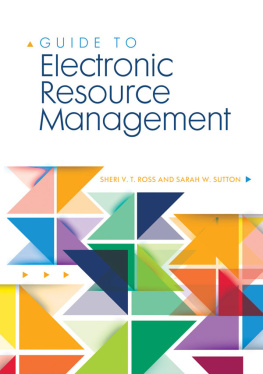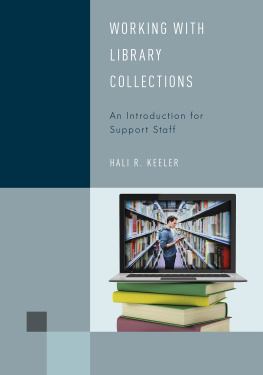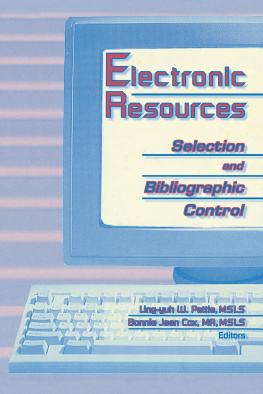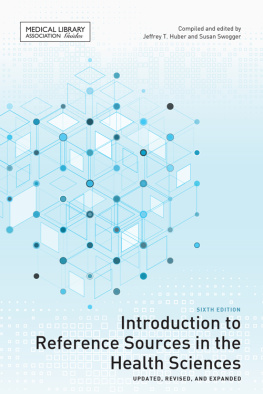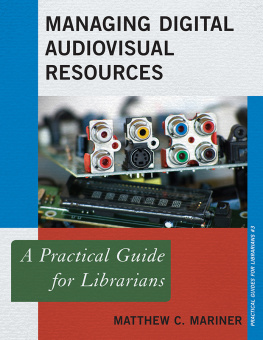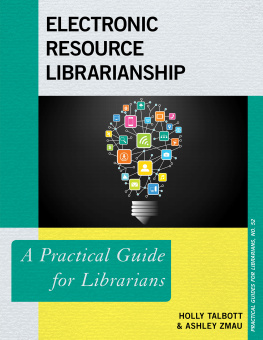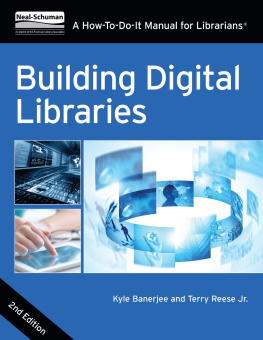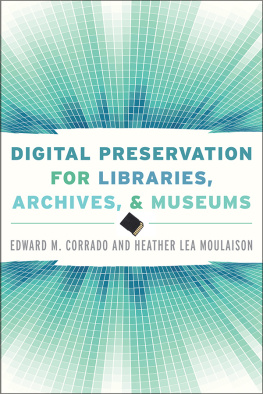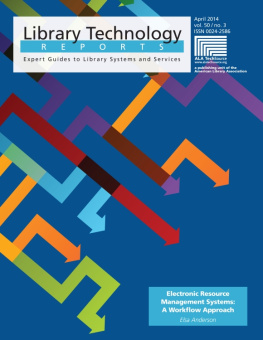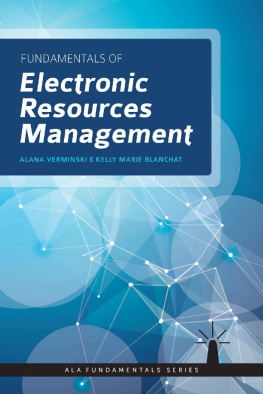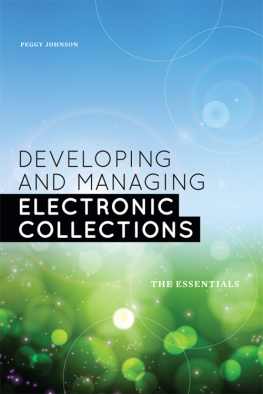Guide to Electronic Resource Management
Guide to Electronic Resource Management
Sheri V. T. Ross and Sarah W. Sutton

Copyright 2016 by Sheri V. T. Ross and Sarah W. Sutton
All rights reserved. No part of this publication may be reproduced, stored in a retrieval system, or transmitted, in any form or by any means, electronic, mechanical, photocopying, recording, or otherwise, except for the inclusion of brief quotations in a review, without prior permission in writing from the publisher.
Library of Congress Cataloging-in-Publication Data
Names: Ross, Sheri V. T., author. | Sutton, Sarah W., author.
Title: Guide to electronic resource management / Sheri V. T. Ross and Sarah W. Sutton.
Description: Santa Barbara, CA : Libraries Unlimited, [2016] | Includes bibliographical references and index.
Identifiers: LCCN 2015037581 | ISBN 9781440839580 (paperback) | ISBN 9781440839597 (ebook)
Subjects: LCSH: LibrariesSpecial collectionsElectronic information resources. | Electronic information resourcesManagement. | BISAC: LANGUAGE ARTS & DISCIPLINES / Library & Information Science / Cataloging & Classification. | LANGUAGE ARTS & DISCIPLINES / Library & Information Science / General.
Classification: LCC Z692.C65 G85 2016 | DDC 025.1dc23
LC record available at http://lccn.loc.gov/2015037581
ISBN: 978-1-4408-3958-0
EISBN: 978-1-4408-3959-7
201918171612345
This book is also available on the World Wide Web as an eBook.
Visit www.abc-clio.com for details.
Libraries Unlimited
An Imprint of ABC-CLIO, LLC
ABC-CLIO, LLC
130 Cremona Drive, P.O. Box 1911
Santa Barbara, California 93116-1911
This book is printed on acid-free paper 
Manufactured in the United States of America
Contents
This textbook developed as a result of need, as many do. Both of us teach electronic resources management in masters level library science programs and struggled to find an up-to-date text. Part of the challenge, of course, is rapid change, which is one of the hallmarks of work with electronic resources in libraries and other information agencies. With that challenge in mind, we have created our own textbook, a distillation of what we strive to teach our students in order to prepare them for work with electronic resources in libraries.
In addition to the clear advantages and disadvantages the electronic resources present for libraries and their customers, there are several aspects of work with electronic resources that are simply different from the work required for their physical counterparts. Most of these differences stem from the increased complexity of both the resources themselves and the work required in order to acquire, organize, provide access to, maintain, troubleshoot, and preserve them. These activities are the focus of this textbook.
, we described some of the possible future directions that electronic resources may take in the future.
Sheri V. T. Ross and Sarah W. Sutton
In the context of libraries and other types of information organizations, when you hear someone refer to electronic resources, that person is most likely talking about an information resource, that is, a container of information content that requires some kind of computer mediation in order to use the content. They are Material (data and/or program[s]) encoded for manipulation by a computerized device. This material may require the use of a peripheral directly connected to a computerized device (e.g., CD-ROM drive) or a connection to a computer network (e.g., the Internet) (AACR and American Library 2002, sec. Glossary). This very broad term encompasses electronic books, electronic journals, digital audio files, digital video files, electronic indexes, and databases. In libraries, then, it refers to information content in a variety of electronic formats that is obtained for use by library customers. It does not generally encompass electronic (e.g., computerized) library systems like the online public access catalog (OPAC), discovery tools, integrated library systems, and so on, which are used by library staff to purchase, track, organize, and otherwise manipulate information content managed by the library. Although there will be some coverage of freely available electronic resources, the focus of this book is on fee-based, licensed electronic resources in libraries and other information institutions.
Electronic library systems have been in use in libraries for decades. Hawthorne (2008) presents an excellent review of the early history of electronic resources in libraries from the first use of machine-readable cataloging in the 1960s to the digitization and delivery of journal indexes and bibliographic databases via CD-ROMs in the 1980s to the surge of content available via the Internet in the 1990s and 2000s.
While academic libraries have always been a primary market for licensed electronic resources, this has begun to change. Public and school libraries are responding to their customers demand for eBooks, audio books, and other online content. In order to help them meet this demand, groups of libraries called consortia form for the purpose of sharing electronic resource costs, management, and sometimes delivery to customers. All types of libraries have become involved in consortial purchasing, which often occurs at the state library level.
Technology and rapid changes have become almost ubiquitous. eBook readers emerged as an exciting new technology in the 2000s, but until the quality of the reading experience improved, they gained little traction with the public. In 2015, the reading public has a wide variety of hardware and software for reading eBooks from which to choose. Half of all Americans owned an eBook reader or tablet computer in 2013, and they are reading eBooks on personal computers and mobile phones (Zickuhr and Rainie 2014). This created a demand that libraries lend eBooks, and libraries responded. Not only do libraries lend eBooks as well as eBook readers, but they also provide access to e-journal content, and they stream audio and video content.
Customer demand for electronic resources in libraries also resulted in the rapid and widespread adoption of demand-driven acquisition, a model for the purchase of electronic content based on customer demand. Demand-driven acquisition is not a new model per se; for example, librarians have been making purchase decisions based on interlibrary loan requests for years. What is new is the ability for a library to load a collection of eBooks into its online catalog and set a threshold number of views, checkouts, and so on, that, when reached, triggers an automatic purchase of the eBook for the librarys collection. Until the threshold point is reached, the library does not acquire (or license) the book.
Rapid advances in technology also make it not just possible but easy to create and share new content via the web. The exponential growth of available electronic content makes it vital that information providers (publishers, libraries, etc.) not only deliver information but also provide the means for customers to find the right information for their purpose. This is another case not of a need to invent something brand new but of a need to allow and seek ways to promote the evolution of current practice to suit new conditions. The principles and values that underlie the practice of librarianship do not change, but the way librarians and other information providers put those principles and values into practice must change.

